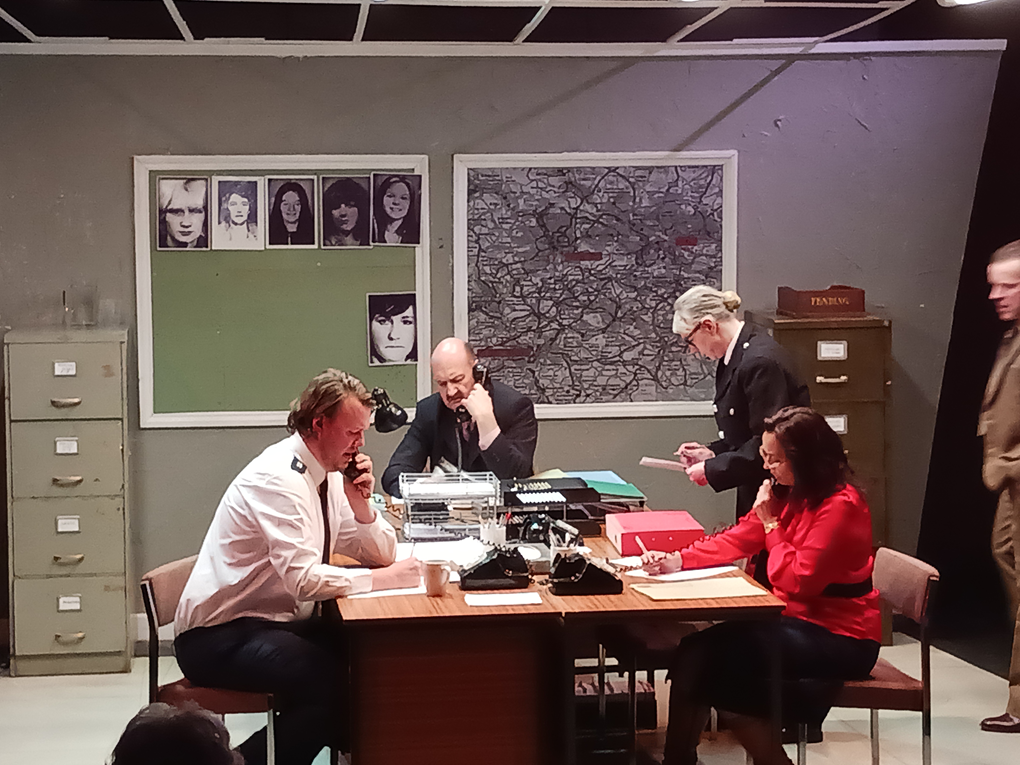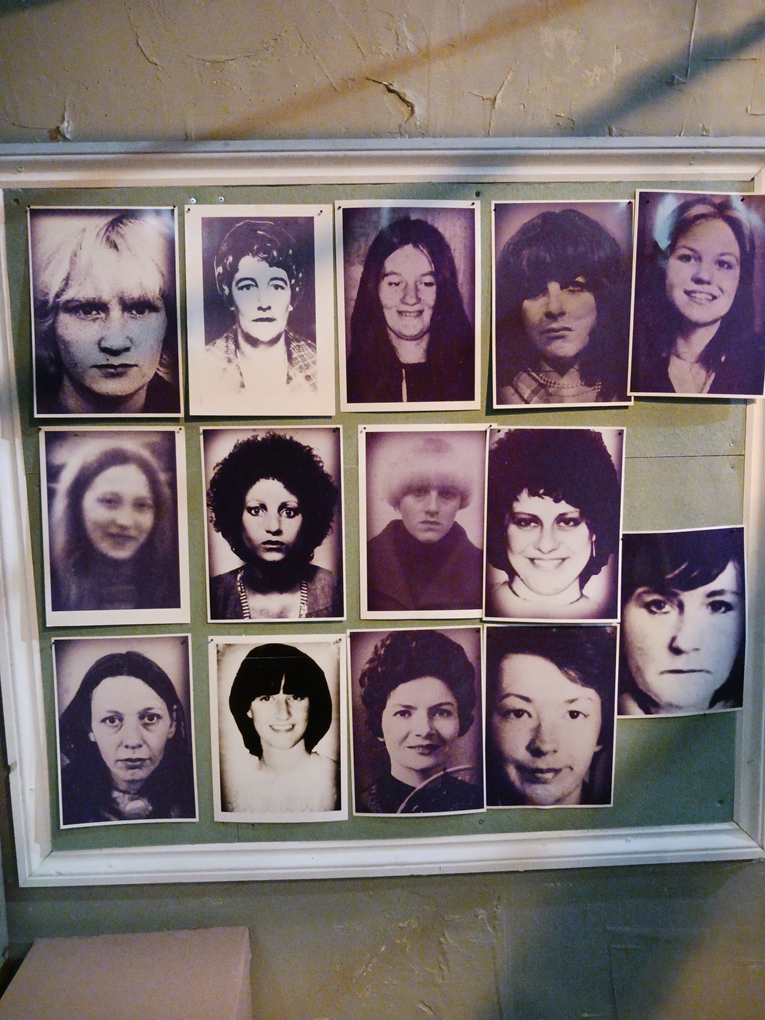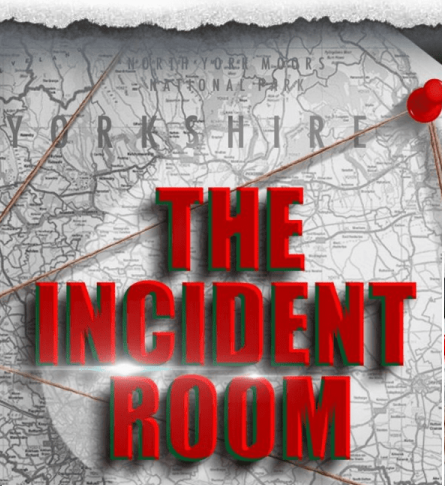by Ian Diddams
images by Ian Diddams
I was born in 1962.
In 1975 I was 13 years old, in my second year at secondary school.
By 1981 was I was about to take A-levels that summer.
In that time Peter Sutcliffe, a.k.a. “The Yorkshire Ripper” murdered thirteen women and attempted to murder seven others.
I grew up in Kent, two hundred and forty-five miles away from the area of those crimes. I was – am – male. It didn’t affect my life. Not directly. Yet, in retrospect it did touch my life, peripherally. A female friend went to university in that area during half that time – another in another part of Yorkshire similarly. A best friend’s dad was a senior officer in the West Yorkshire Constabulary, though not attached to the police investigations. And it was a dominant, recurring news story, alongside the Northern Irish “troubles”. For six years.
“The Incident Room” by Olivia Hirst and David Byrne, tells the tale of the West Yorkshire police’s investigation, seen through the characters of five C.I.D. and one uniform officers, one civilian special constable, and a journalist. Adding context and background is a party girl and a taxi driver – one a survivor, the other a suspect. It’s a fairly no-holds barred expose of the misguided processes and investigative lines taken, of the egos and personalities that ultimately proved to be so disastrously wrong in the “Ripper Enquiry”. It is also a portrayal of the humans behind those decisions and the impacts on their lives. It carries an increasingly strong message of female suppression, misogyny and general undertones of constant rivalries threaded throughout the story. It is a story of ultimate triumph – but one that is hugely clouded by self-doubts, missed opportunities, ruined careers.
Platform 8 Productions have embraced all the above and delivered it, in spades. The Rondo Theatre’s intimate space works well with the short, sharp-scened focus of the play. Rich Canning has once again excelled with his set design encapsulating the increasingly oppressive and crushing confines of the Millgarth office with areas for external scenes as stage left and right. The design draws the eye into the very nub of the entire issue at hand … the pin board where, as the death toll rises, the board gets filled with the stark photos of the victims, plus the attack survivor, Maureen Long’s. This is a tech heavy show and the tech crew of Will Ward, Alex Latham (who else at the Rondo?!) and Julie Dallimore have delivered director Nadine Comba’s wonderful visions to a tee – time slips with ticking sounds and flickering lights a constant thread as the scenes race through the years of the case, stark office lighting, subdued 4am paperwork and filing… not to forget the disco and driving music of course.

As so the cast… this is a character driven story as well as being a “history”, as opined previously. And the cast perform the characters SO believably. As the play progresses each character grows stronger. There’s George Oldfield, in charge, played by Mark Hale. All brusque and bullish at first, but the job wears him down of course and by the end he is broken, a spent and bitter man. Mark’s mannerisms reminded me of somebody I knew, perfectly… Dick Holland, played by Rich Canning (of set fame!) is Oldfield’s number two and he shows Holland’s devotion to Oldfield and … interest… in special constable and man-hunter Sylvia Swanson played deliciously by Alex Oliviere. PC then DS Andrew Laptew, played by Matt Rushton, grows from “Bradford Twat” to sure footed detective until being crushed by the weight of his realisations over his suspicions that were glossed over and he didn’t push. Steve Brookes came to the cast quite late to play Jim Hobson, the tyre specialist – forthright and convinced of his leads. It’s a small part in the overall play but Steve makes his mark in the opening salvos with Oldfield well. Louche and cocksure Jack Ridgway is superbly acted by Chris Constantine, all swagger and insouciance, delivering his barbed pro-Manchester, anti-Yorkshire remarks to perfection – he is the boyfriend you hope your daughter never brings home. Chris doubles up as sometime suspect, taxi driver Terence Hawkshaw with an interesting 1970s style beard! How does he shave it off so quickly and grow it back again every night ? Then there is conniving, ambitious, feminist Tish Morgan played by Leah Brine with her eye for the main chance and the big scoop and not caring who gets hurt en route, and the survivor Maureen Long acted by Jude Bucklow, capturing the loss of joie de vivre and ultimate depression so poignantly.

That leaves just one character – that of Megan Winterburn, uniformed sergeant and controller of the incident room. Meg is on stage for the entire show – or if she isn’t I must have blinked and missed it. The play – though being a quasi-historical record and about one perpetrator in particular, is really about Meg. Of her struggles against a male dominated workplace and her self-doubt and blame of how she may have missed something along the way. Her in-the-future reflections with Holland frame the story throughout underpinning each section of the investigation. It’s a huge part and the core and crux of the performance and so chapeau to Alexia Jones for a bravado delivery par excellence. Absolutely super.
The play works on multiple levels. Yes, it’s about a famous police investigation. But its also so much more. It’s a play about rivalries. Between different police forces, different counties, different regions, different sexes, different professions. Misogyny is rife, but so is distrust of others – whether they be from Bradford, Manchester, London… or non-coppers. It’s a play about pig headed stubbornness, about detrimental devotion to superiors. About social bigotry. It’s the 1970s in a nutshell…
Ultimately the police get their man. But not through the thousands of hours spent on the investigation – but a chance encounter by two uniforms in a red light district. Two years after Laptew had tried to file a report about the killer. The play thus is really about failure – individual’s failures because of stubbornness, or devotion, or misdirection. Oldfield loses his job, Holland his marriage, Megan her self belief, Laptew his career, Maureen her confidence. Ridgway and Hobson survive to fight another day but tarnished by association.
Its only Tish that “wins” – her career climbs from Yorkshire Post to Daily Mirror to Sunday Times. Whether we are left feeling she is a “winner” is open to conjecture.

And finally… Towards the end of the play Meg comments to Tish about a book to be published about the Ripper and the investigation, that it is isn’t journalism, but merely “entertainment” and “tittle tattle”. It’s a reminder maybe that what we are watching is in some ways “entertainment”. A play in a theatre. About the subject of the book that Meg is decrying. Though I’d suggest “The Incident Room” is far from tittle-tattle.
There are thirteen characters that haven’t had a mention in this review, in the cast list. But without them this story won’t ever have happened, this play never written. This top performance by Platform 8 Productions would not be showing. And its them that we should remember – the people that ended up as a photo on a pin board in …
“The Incident Room”.

Wilma McCann Emily Jackson Irene Richardson Patricia Atkinson Jayne MacDonald Jean Jordan Yvonne Pearson Helen Rytka Vera Millward Josephine Whitaker Barbara Leach Marguerite Walls Jacqueline Hill
“The Incident Room” plays at the Rondo Theatre, Larkhall, Bath from May 1st to 4th 2024
Tickets from https://www.ticketsource.co.uk/whats-on/bath/rondo-theatre/the-incident-room/e-vqryvo

